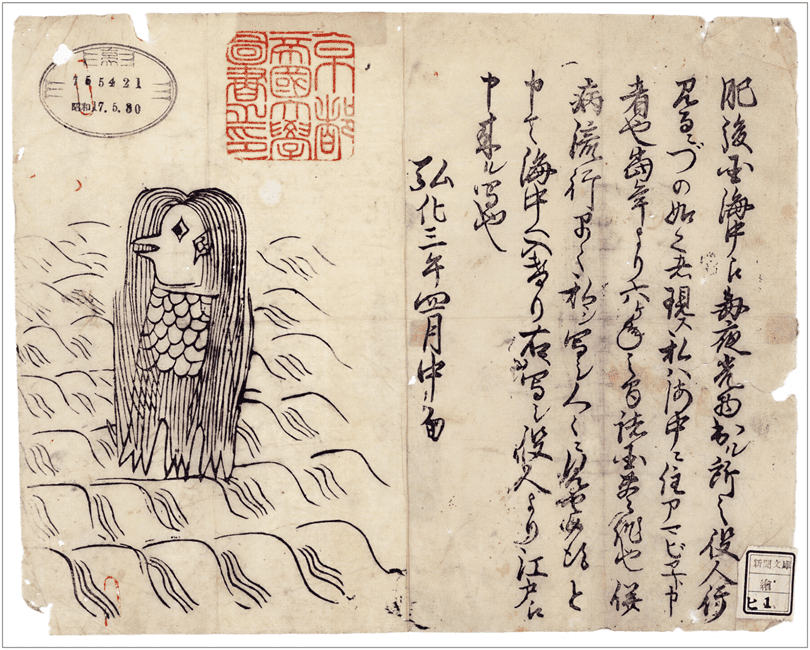In 1846, a Japanese sailor whose name would be lost to history noticed a weird flashing light out at sea. He reported going out to investigate it and seeing a spectral mermaid-like creature. The creature, called Amabié, left a brief but clear message:
“I live in the sea. My name is Amabié. Good harvest will continue for six years. At the same time disease will spread. Draw me and show me to the people as soon as possible,” the creature said, before submerging.
In 2020, Amabié has become a popular symbol against the COVID-19 pandemic, and even more — she has become a symbol of hope, with people rallying behind Amabié as a symbol against the pandemic.

The face of a pandemic
We, humans, are fickle creatures. We often fall prey to our emotions and illogical beliefs at the expense of facts, and this pandemic has proven to be no different. The importance of rallying symbols has been discussed in multiple contexts, and having a “flag” to rally around can make all the difference. Amabié is not the most obvious symbol by any means, but it has become extremely popular, and you can see it everywhere: on posters encouraging people to not go outside unnecessarily, on mugs and t-shirts, and even on urban art.
The first tweet connecting Amabié to the COVID-19 pandemic appeared on January 30, 2020 — when the disease had not been declared a pandemic yet. Then, one month later, at the end of February, artist Orochidō reignited interest in the character with a tweet of a contemporary painting and a call to draw and share more images of #Amabie. The phenomenon took off almost instantly on social media.
There were 28 tweets with the term “Amabié” (in Japanese) on March 1, and more than 1,000 on March 4. There were 10-20,000 tweets almost every day in April, and there are still a few thousand tweets with the hashtag every day. Amabié had become a social media phenomenon.
Amabié has become popular with the young and social media savvy — a social category that’s typically difficult to reach with medical messages. In fact, Amabié has become so viral that the government also uses the symbol in its communication. It’s featured on the contact tracing app and in official messages, alongside popular manga and anime characters, which Japan has also used in its pandemic communication.
There are stand-up Amabié art exhibitions held all around the country, and the character is featured in plenty of different media, including sculpture, glass, and textile arts. Amabié stuffed dolls have also become popular.

Translation, top: Now is the time to keep in step with each other. Let’s make a conscious effort to refrain [from going outside unnecessarily], and aim for an early end together! JR East Shimbashi Station. Left to right.
1, Stay Home: We are preparing and waiting now for the day when you can travel safely and comfortably on the railways. #Let’s start from Shimbashi.
2, Hope to see you again when we are back to normal. Until that time, when we can meet again and laugh, be patient for now. Corona, bye-bye.
3, There are lives that can be protected by each of us taking care of ourselves. #Cough etiquette. #Two meters apart. #Wash your hands repeatedly. Your patience will save the world! Take action to keep it from transferring to others.
4, Thank you! Medical professionals who have been at the forefront of this crisis and have been fighting day and night, thank you for everything. That’s why, we need to make an effort to defend ourselves and not burden them anymore.
5, Thank you for taking care of each other! One for All, All for One. Let’s all beat Corona!
Demons to the rescue
According to Japanese lore, Amabié isn’t exactly a demon. Instead, she is a yōkai — a group of supernatural creatures without a direct equivalent in western mythology. Yōkai can be considered monsters, spirits, or demons, but not all are malevolent, some are considered to bring good luck or fortune. Instead, the yōkai are a sort of specter, bringing supernatural phenomena into the realm of humans.
This particular yōkai is being used to ward off COVID-19.

Amabié, despite being a mer-creature of the 19th century, also fits into more recent cultural trends, especially kimo-kawaii (something that is both ugly and cute at the same time) and heta-uma (something that is poorly made at first glance but has depth and is captivating).
The prosaic out there will argue that Amabié isn’t real. She’s just a figment of some sailors’ imagination that got preserved as a curiosity in a museum. Sure, you could say that. But is she less real than the conspiracy theories around face masks or 5G? Something doesn’t necessarily need to be real to have an impact, and we’ve seen plenty of that over the course of the pandemic.
Having something to rally around can be immensely important for people’s morale and for reaching diverse audiences with important messages. People want something to believe in. If it’s a mythical creature that gives people hope and encourages them to take the disease seriously, why not?






